
1
PRACTICE TEST 13
Read the following passage and mark the letter A, B, C or D on your answer sheet to indicate the
correct word for each of the blanks from 1 to 10
It is estimated the (1) _____ number is not known that worldwide some 60,000 newspapers exist with a
(2) _____ circulation of nearly 500 million. However, the number of readers is (3) _____ greater-as many
as three times the circulation figure.
This is because newspapers are shared, some are posted, and (4) _____ placed in libraries and other (5)
_____ places. Worldwide, about 8,000 of these newspapers are dailies. About a third of all newspapers
are published in North America, (6) _____ third in Europe, and the (7) _____ third in the rest of the
world. Countries with the highest newspaper (8) _____ are Britain, Norway, Denmark, Sweden, Japan,
and the United States. Europe has nearly half of the world's total newspaper circulation, North America
about a quarter, and the rest of the world another quarter. Taking the world (9) _____, the average
circulation of dailies per 1,000 persons is about 100, but there are many parts of the world where the
modern newspaper is (10) _____ ever seen.
Question 1: A. exact B. correct C. precise D. right
Question 2: A. mixed B. combined C. connected D. linked
Question 3: A. even B. far C. more D. very
Question 4: A. another B. the others C. others D. the rest
Question 5: A. open B. common C. shared D. public
Question 6: A. the other B. the next C. another D. the last
Question 7: A. extra B. left C. spare D. remaining
Question 8: A. readers B. buyers C. readership D. subscribers
Question 9: A. as a whole B. generally C. on general D. in all
Question 10: A. almost B. not C. seldom D. scarcely
Read the following passage and mark the letter A, B, C, or D on your answer sheet to indicate the
correct answer to each of the questions from 11 to 20
The fertile valleys of the river Nile straddle the hot desert land of Egypt. Rain is relatively scarce, and
the summers are scorching hot. Nevertheless the strip of land, known as the Cultivation, on either side of
the Nile is reputed to be one of the most fertile places in the world. Its rich black soil is the result of
accumulation of silt deposited by the annual flooding of the Nile thousands of years ago. From June to
October, the river overflowed its banks. Modern damps were then constructed to control the flooding. The
floodwaters left behind a rich sticky black mud which made it suitable for the cultivation of crops. As
long as the soil was well irrigated, two or three crops could be grown in one season. Its rich soil led to the
growth and rise of the brilliant civilization of the ancient Egyptians on the Nile valley more than 5000
years ago. The earliest Egyptians had acquired the skills to till the land along the banks, drawing along the
Nile became wealthy, they embarked on projects of digging ditches and constructing dams to control the
floods.
In about 3100 BC, the whole Egypt was united under the reign of King Menes. He and his descendants
made up Egypt's first ruling family, or dynasty. His rule led to the great development of the arts like
writing, painting, architecture, and crafts. Egyptian power and influence were to last for the next 2000
years. The Egyptian kings had absolute powers. The king possesses all the land, and the peasants had to
surrender part of their crops to the king. An army of officials and scribes did the task of collecting the
exact amount of due from the individual farmers. Crops and livestock were often seen at the storehouses
surrounding the royal palaces. In return for their uphill task, the king paid his officials and dishes out
funds for huge irrigation projects. Egypt's trade with the outside world stretches far and wide. In return for
gold, copper, gemstones, and building stones, it purchases the goods that it did not have. Timber, resins,
oils, silver and slaves came from Lebanon. From Deria and Anatolia came horses, while the blue stone
called lapis lazuli was imported from Mesopotamia. Strong forts were constructed to protect overland
trade routes. Egypt held Nubia in the south for almost 800 years. It served as Egypt's most vital source of
gold and slaves.

2
Question 11: The civilization of the ancient Egyptians was brought about by _____.
A. Egypt's first ruling family
B. the rich alluvial soil of the Nile
C. Egypt's trade with the outside world
D. the highly-developed writing, painting, architecture and crafts
Question 12: Egyptian slaves came from _____.
A. Syria and Anatolia B. Palestine C. Mesopotamia D. Lebanon
Question 13: The king was wealthy because _____.
A. he possessed all the land B. huge irrigation projects were set up
C. he was in absolute power D. farmers paid him their tribute
Question 14: The writer said that the annual flooding of the Nile _____.
A. needed to be controlled B. led to the discovery of new mines
C. caused an influx of foreign traders D. helped to develop the arts
Question 15: According to the passage, the king was wise _____.
A. to own slaves and gold B. to pay for huge irrigation projects
C. to control the land D. to import the things that Egypt did not have
Question 16: In return for, in the first line, last paragraph, refers to _____.
A. what Egypt exported B. how fast the profit came
C. the respect Egypt received D. the protection the Egyptian army provided
Question 17: A suitable title for this passage is _____.
A. The Farming Methods of the Egyptians B. The Landscape of the Egypt
C. The Might of the Egyptian Army D. The Civilization of the Ancient Egyptians
Question 18: We know the Egyptian Empire was powerful from the _____.
A. long period it extended its power and influence
B. way its army fought with other invaders
C. number of crops grown in one season
D. trade and business done with other nations
Question 19: Farm crops would be _____ if there was no water for irrigation.
A. harvested B. unavailable C. unprotected D. destroyed
Question 20: From June to October, the flood plains would be _____.
A. open to the building of new B. left to the sowing of new crops dams
C. raised to a higher level D. inundated with floodwaters from the Nile
Mark the letter A, B, C, or D on your answer sheet to indicate the word that differs from the rest in the
position of the main stress in each of the following questions
Question 21: A. definition B. necessity C. incredible D. humidity
Question 22: A. sentence B. translator C. prefix D. transitive
Question 23: A. remind B. discovery C. magazine D. inform
Question 24: A. conscious B. parameter C. thermometer D. speedometer
Question 25: A. begin B. kingdom C. mountain D. passage
Read the following passage and mark the letter A, B, C, or D on your answer sheet to indicate the
correct answer to each of the questions from 26 to 35
Accustomed though we are to speaking of the films made before 1927 as "silent", the film has never
been, in the full sense of the word, silent. From the very beginning, music was regarded as an
indispensable accompaniment; when the Lumiere films were shown at the first public film exhibition in
the United States in February 1896, they were accompanied by piano improvisations on popular tunes. At
first, the music played bore no special relationship to the films; an accompaniment of any kind was
sufficient. Within a very short time, however, the incongruity of playing lively music to a solemn film
became apparent, and film pianists began to take some care in matching their pieces to the mood of the
film.
As movie theaters grew in number and importance, a violinist, and perhaps a cellist would be added to
the pianist in certain cases, and in the larger movie theaters small orchestras were formed. For a number
of years the selection of music for each film program rested entirely in the hands of the conductor or
leader of the orchestra, and very often the principal qualification for holding such a position was not skill
or taste so much as the ownership of a large personal library of musical pieces. Since the conductor

3
seldom saw the films until the night before they were to be shown (if, indeed, the conductor was lucky
enough to see them then), the musical arrangement was normally improvised in the greatest hurry.
To help meet this difficulty, film distributing companies started the practice of publishing suggestions
for musical accompaniments. In 1909, for example, the Edison Company began issuing with their films
such indications of mood as "pleasant', "sad", "lively". The suggestions became more explicit, and so
emerged the musical cue sheet containing indications of mood, the titles of suitable pieces of music, and
precise directions to show where one piece led into the next.
Certain films had music especially composed for them. The most famous of these early special scores
was that composed and arranged for D. W. Griffith's film Birth of a Nation, which was released in 1915.
Question 26: The passage mainly discusses music that was _____.
A. specifically composed for certain movie theaters
B. performed before the showing of a film
C. played during silent films
D. recorded during film exhibitions
Question 27: What can be inferred that the passage about the majority of films made after 1927?
A. They were accompanied by symphonic orchestras.
B. They were truly "silent".
C. They incorporated the sound of the actors' voices.
D. They corresponded to specific musical compositions.
Question 28: The word "solemn" in paragraph 1 is closest in meaning to _____.
A. serious B. simple C. silent D. short
Question 29: It can be inferred that orchestra conductors who worked in movie theaters needed to _____.
A. have pleasant voices
B. be familiar with a wide variety of music
C. be able to compose original music
D. be able to play many instruments
Question 30: The word "them" in paragraph 2 refers to _____.
A. hands B. pieces C. films D. years
Question 31: According to the passage, what kind of business was the Edison Company?
A. It made musical instruments.
B. It produced electricity.
C. It published musical arrangements.
D. It distributed films.
Question 32: It may be inferred from the passage that the first musical cue sheets appeared around _____.
A. 1896 B. 1927 C. 1915 D. 1909
Question 33: Which of the following notations is most likely to have been included on a musical cue
sheet of the early 1900's?
A. "Piano, violin" B. "Key of C major"
C. "Calm, peaceful" D. "Directed by D. W. Griffith"
Question 34: The word "scores" in paragraph 4 is closest in meaning to _____.
A. successes B. totals
C. groups of musicians D. musical compositions
Question 35: The passage probably continues with a discussion of _____.
A. silent films by other directors
B. famous composers of the early twentieth century
C. other films directed by D. W. Griffith
D. the music in Birth of a Nation
Mark the letter A, B, C, or D on your answer sheet to indicate the correct answer to each of the
following questions
Question 36: My cousin obviously didn't _____ much of an impression on you if you can't remember
meeting her.
A. do B. make C. create D. build
Question 37: The tennis match was put off because of the heavy rain.
A. damaged B. postponed C. canceled D. destroyed




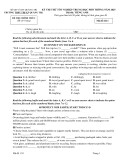
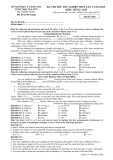
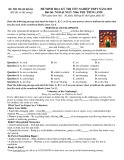
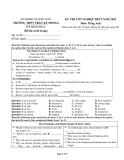
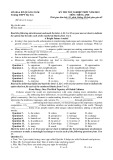
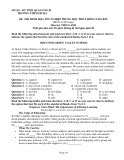
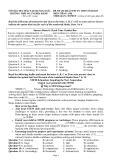











![Đề thi Tiếng Anh có đáp án [kèm lời giải chi tiết]](https://cdn.tailieu.vn/images/document/thumbnail/2025/20250810/duykpmg/135x160/64731754886819.jpg)



